Effect of Composite Bionic Micro-Texture on Cutting Performance of Tools
Abstract
:1. Introduction
2. Theoretical Models
2.1. Metal Cutting Theory
2.2. Sources of Biomimetic Micro-Textures
3. Finite Element Simulation Experiments of Bionic Micro-Textured Tools
3.1. Three-Dimensional Modeling
3.2. Bionic Micro-Texture Finite Element Simulation Experiment
3.3. Experimental Results and Analyses
3.3.1. Impact of Micro-Textured Material on Cutting Forces
3.3.2. Impact of Micro-Textured Surfaces on Stress Levels
3.3.3. Impact of Micro-Textures on the Temperature at Which Cutting Occurs
4. Bionic Micro-Textured Tool Cutting Experiments
4.1. Composite Biomimetic Micro-Textured Tool Preparation
4.2. Bionic Micro-Textured Tool Cutting Laboratory
4.3. Experimental Results and Analysis
4.3.1. Impact of Combined Bionic Micro-Texture Elements on Slicing Forces
4.3.2. Impact of Combined Bionic Micro-Textured Factors on the Texture of Surface
4.3.3. Impact of Combined Biomimetic Micro-Textured Variables on Microchips
5. Conclusions
Author Contributions
Funding
Data Availability Statement
Acknowledgments
Conflicts of Interest
References
- Fabián Pérez-Salinas, C.; Fernández-Lucio, P.; del Olmo, A.; Aldekoa-Gallarza, I.; Norberto López de Lacalle, L. The influence of cutting edge microgeometry on the broaching of Inconel 718 slots. Eng. Sci. Technol. Int. J. 2023, 48, 101563. [Google Scholar] [CrossRef]
- Ghosh, S.; Rao, P.V. Application of sustainable techniques in metal cutting for enhanced machinability: A review. J. Clean. Prod. 2015, 100, 17–34. [Google Scholar]
- Aouici, H.; Yallese, M.A.; Chaoui, K.; Mabrouki, T.; Rigal, J.F. Analysis of surface roughness and cutting force components in hard turning with CBN tool: Prediction model and cutting conditions optimization. Measurement 2012, 45, 344–353. [Google Scholar] [CrossRef]
- Liu, K.; Li, X.P.; Rahman, M.; Liu, X.D. CBN tool wear in ductile cutting of tungsten carbide. Wear 2003, 255, 1344–1351. [Google Scholar] [CrossRef]
- Stephenson, D.A.; Agapiou, J.S. Metal Cutting Theory and Practice; CRC Press: Boca Raton, FL, USA, 2018. [Google Scholar]
- Li, B. A review of tool wear estimation using theoretical analysis and numerical simulation technologies. Int. J. Refract. Met. Hard Mater. 2012, 35, 143–151. [Google Scholar] [CrossRef]
- Iliescu DM, F.D.; Gehin, D.; Gutierrez, M.E.; Girot, F. Modeling and tool wear in drilling of CFRP. Int. J. Mach. Tools Manuf. 2010, 50, 204–213. [Google Scholar] [CrossRef]
- Patel, D.S.; Jain, V.K.; Shrivastava, A.; Ramkumar, J. Electrochemical micro texturing on flat and curved surfaces: Simulation and experiments. Int. J. Adv. Manuf. Technol. 2019, 100, 1269–1286. [Google Scholar] [CrossRef]
- Khani, S.; Razfar, M.R.; Haghighi, S.S.; Farahnakian, M. Optimization of micro-textured tools parameters in thread turning process of aluminum 7075 aerospace alloy. Mater. Manuf. Process. 2020, 35, 1330–1338. [Google Scholar] [CrossRef]
- Kümmel, J.; Braun, D.; Gibmeier, J.; Schneider, J.; Greiner, C.; Schulze, V.; Wanner, A. Study on micro texturing of uncoated cemented carbide cutting tools for wear improvement and built-up edge stabilisation. J. Mater. Process. Technol. 2015, 215, 62–70. [Google Scholar] [CrossRef]
- Ellersiek, L.; Menze, C.; Sauer, F.; Denkena, B.; Möhring, H.C.; Schulze, V. Evaluation of methods for measuring tool-chip contact length in wet machining using different approaches (micro-textured tool, in-situ visualization and restricted contact tool). Prod. Eng. 2022, 16, 635–646. [Google Scholar] [CrossRef]
- Fouathiya, A.; Meziani, S.; Sahli, M.; Barrière, T. Experimental investigation of micro-textured cutting tool performance in titanium alloy via turning. J. Manuf. Process. 2021, 69, 33–46. [Google Scholar] [CrossRef]
- Du, H.Y.; He, L.; Du, H.S.; Ma, K.J.; Li, Y.P. Bionic tribological tool weaving design. Comb. Mach. Tools Autom. Mach. Technol. 2016, 506, 138–142. [Google Scholar] [CrossRef]
- You, C.; Xie, C.; Chu, X.; Zhou, W.; Zhao, G.; Lian, Y. Cutting performance of bionic cutting tools based on surface microstructures of blood clam Tegillarca granosa in dry cutting of CFRP. Int. J. Adv. Manuf. Technol. 2022, 119, 2961–2969. [Google Scholar] [CrossRef]
- Neugebauer, R.; Drossel, W.G.; Ihlenfeldt, S.; Harzbecker, C. Design method for machine tools with bionic inspired kinematics. CIRP Ann. 2009, 58, 371–374. [Google Scholar] [CrossRef]
- Yu, H.; Han, Z.; Zhang, J.; Zhang, S. Bionic design of tools in cutting: Reducing adhesion, abrasion or friction. Wear 2021, 482, 203955. [Google Scholar] [CrossRef]
- Cui, X.; Duan, S.; Guo, J.; Ming, P. Bionic multifunctional surface microstructure for efficient improvement of tool performance in green interrupted hard cutting. J. Mater. Process. Technol. 2022, 305, 117587. [Google Scholar] [CrossRef]
- You, C.; Zhao, G.; Chu, X.; Zhou, W.; Long, Y.; Lian, Y. Design, preparation and cutting performance of bionic cutting tools based on head microstructures of dung beetle. J. Manuf. Process. 2020, 58, 129–135. [Google Scholar] [CrossRef]
- Akhtar, S.S. A critical review on self-lubricating ceramic-composite cutting tools. Ceram. Int. 2021, 47, 20745–20767. [Google Scholar] [CrossRef]
- Wu, Z.; Deng, J.; Chen, Y.; Xing, Y.; Zhao, J. Performance of the self-lubricating textured tools in dry cutting of Ti-6Al-4V. Int. J. Adv. Manuf. Technol. 2012, 62, 943–951. [Google Scholar]
- Wu, Z.; Deng, J.; Su, C.; Luo, C.; Xia, D. Performance of the micro-texture self-lubricating and pulsating heat pipe self-cooling tools in dry cutting process. Int. J. Refract. Met. Hard Mater. 2014, 45, 238–248. [Google Scholar] [CrossRef]
- Qin, S.; Shi, X.; Xue, Y.; Zhang, K.; Huang, Q.; Wu, C.; Shu, J. Coupling effects of bionic textures with composite solid lubricants to improve tribological properties of TC4 alloy. Tribol. Int. 2022, 173, 107691. [Google Scholar] [CrossRef]
- Zheng, K.; Yang, F.; Pan, M.; Zhao, G.; Bian, D. Effect of surface line/regular hexagonal texture on tribological performance of cemented carbide tool for machining Ti-6Al-4V alloys. Int. J. Adv. Manuf. Technol. 2021, 116, 3149–3162. [Google Scholar] [CrossRef]
- Zhao, C.; Long, R.; Zhang, Y.; Wang, Y.; Wang, Y. Influence of characteristic parameters on the tribological properties of vein-bionic textured cylindrical roller thrust bearings. Tribol. Int. 2022, 175, 107861. [Google Scholar] [CrossRef]
- Liu, G.L.; Zheng, J.T.; Huang, C.Z.; Sun, S.F.; Liu, X.F.; Dai, L.J.; Wang, X.Y. Coupling effect of micro-textured tools and cooling conditions on the turning performance of aluminum alloy 6061. Adv. Manuf. 2023, 11, 663–681. [Google Scholar] [CrossRef]
- Yu, Q.; Zhang, X.; Miao, X.; Liu, X.; Zhang, L. Performances of concave and convex microtexture tools in turning of Ti6Al4V with lubrication. Int. J. Adv. Manuf. Technol. 2020, 109, 1071–1092. [Google Scholar] [CrossRef]
- Gajrani, K.K.; Sankar, M.R.; Dixit, U.S. Tribological performance of MoS2-filled microtextured cutting tools during dry sliding test. J. Tribol. 2018, 140, 021301. [Google Scholar] [CrossRef]
- Gao, G.; Wang, Y.; Fu, Z.; Zhao, C.; Xiang, D.; Zhao, B. Review of multi-dimensional ultrasonic vibration machining for aeronautical hard-to-cut materials. Int. J. Adv. Manuf. Technol. 2023, 124, 681–707. [Google Scholar] [CrossRef]
- Tapia, E.; Sastoque-Pinilla, L.; De Lacalle, N.L.; Lopez-Novoa, U. Towards real time monitoring of an aeronautical machining process using scalable technologies. In Proceedings of the 2022 7th International Conference on Smart and Sustainable Technologies (SpliTech), Split/Bol, Croatia, 5–8 July 2022; pp. 1–6. [Google Scholar]
- Cui, X.; Li, C.; Ding, W.; Chen, Y.; Mao, C.; Xu, X.; Liu, B.; Wang, D.; Li, H.N.; Zhang, Y.; et al. Minimum quantity lubrication machining of aeronautical materials using carbon group nanolubricant: From mechanisms to application. Chin. J. Aeronaut. 2022, 35, 85–112. [Google Scholar] [CrossRef]
- Pang, K.; Wang, D. Study on the performances of the drilling process of nickel-based superalloy Inconel 718 with differently micro-textured drilling tools. Int. J. Mech. Sci. 2020, 180, 105658. [Google Scholar] [CrossRef]
- Fan, L.; Deng, Z.L.; He, Y.; Zhu, X.L.; Gao, X.J.; Jin, Z. The effects of micro-texture shape on serrated chip geometry in the hardened steel AISI D2 cutting process. Surf. Topogr. Metrol. Prop. 2022, 10, 015031. [Google Scholar] [CrossRef]
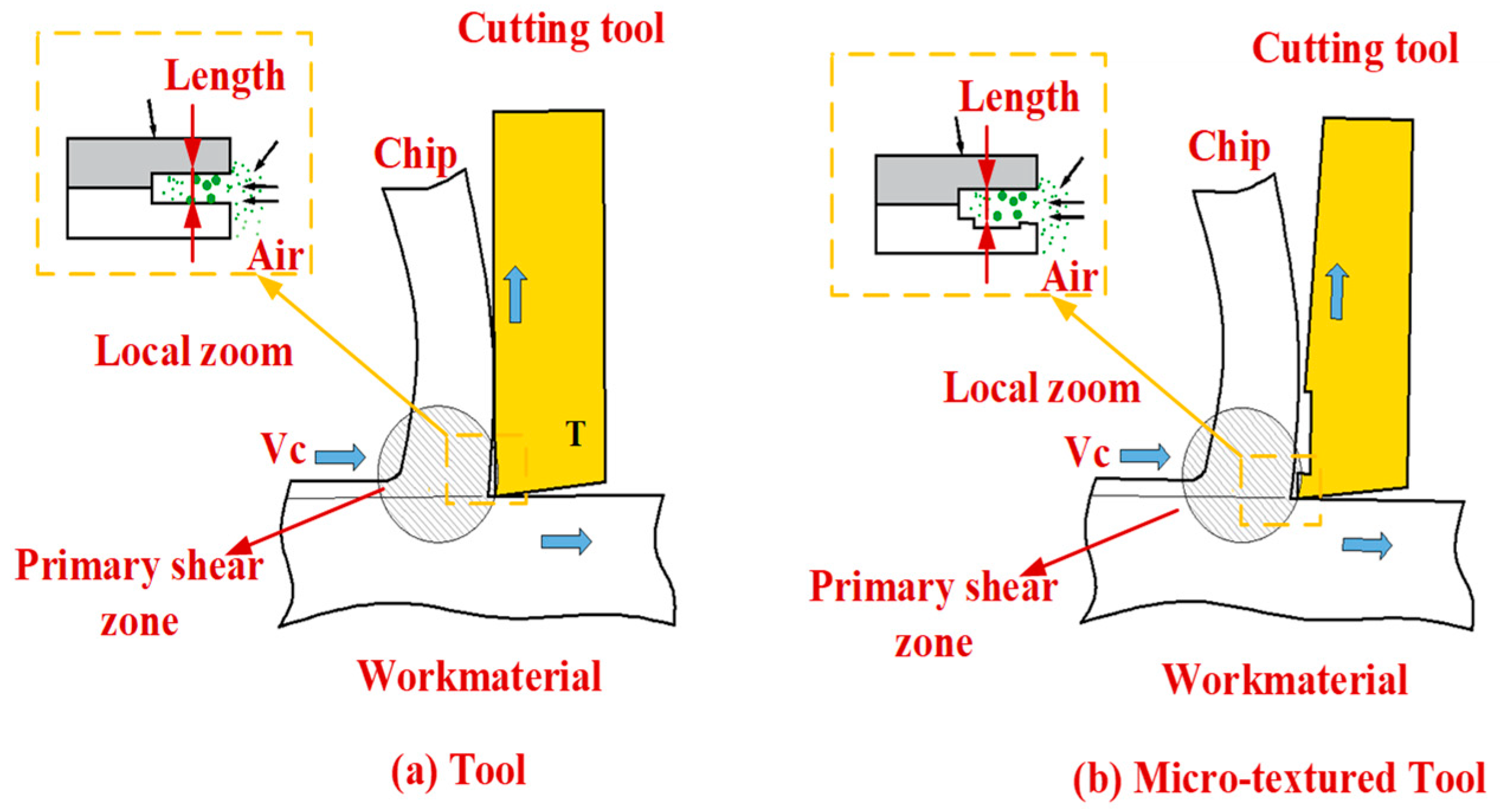
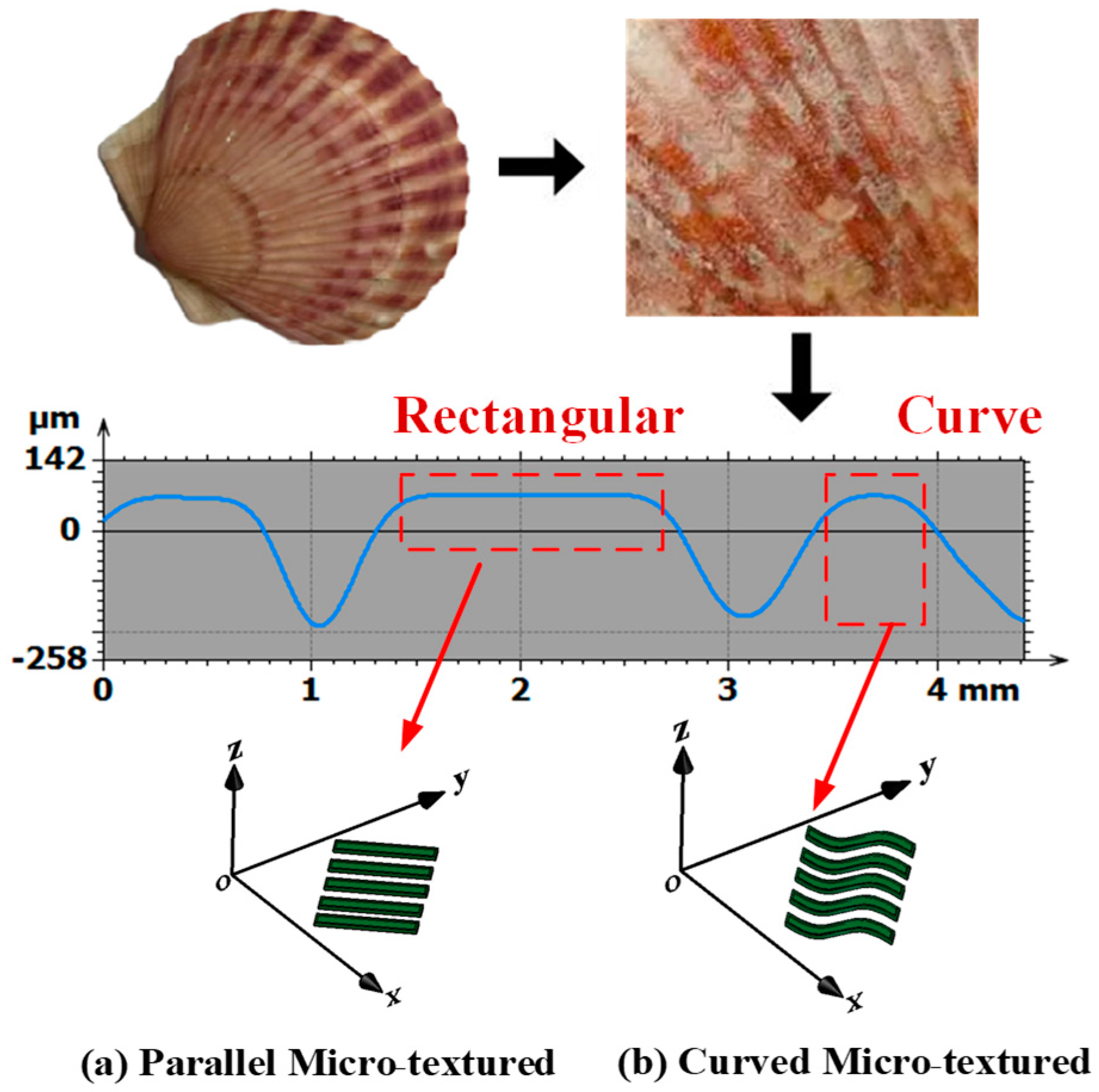

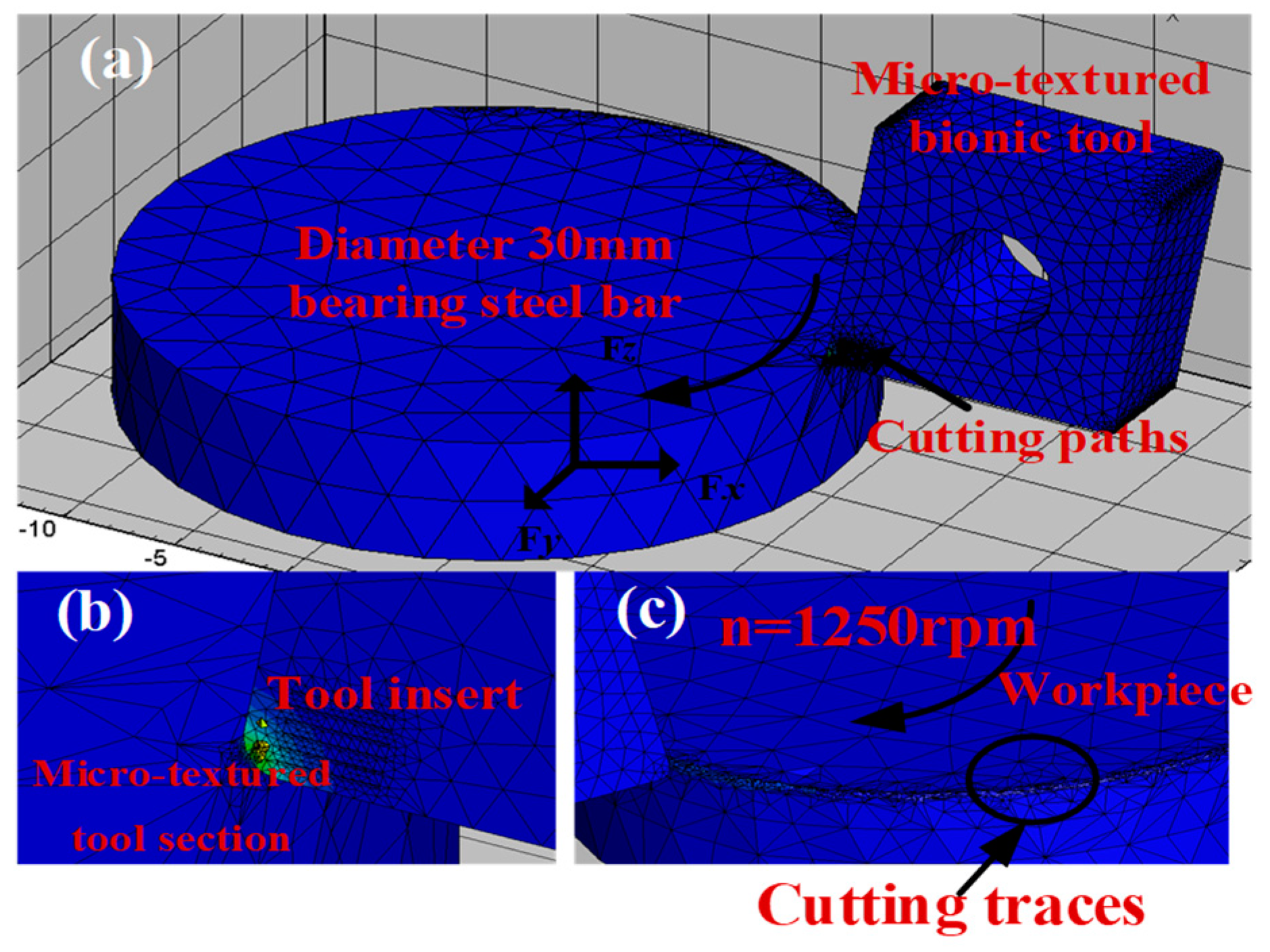
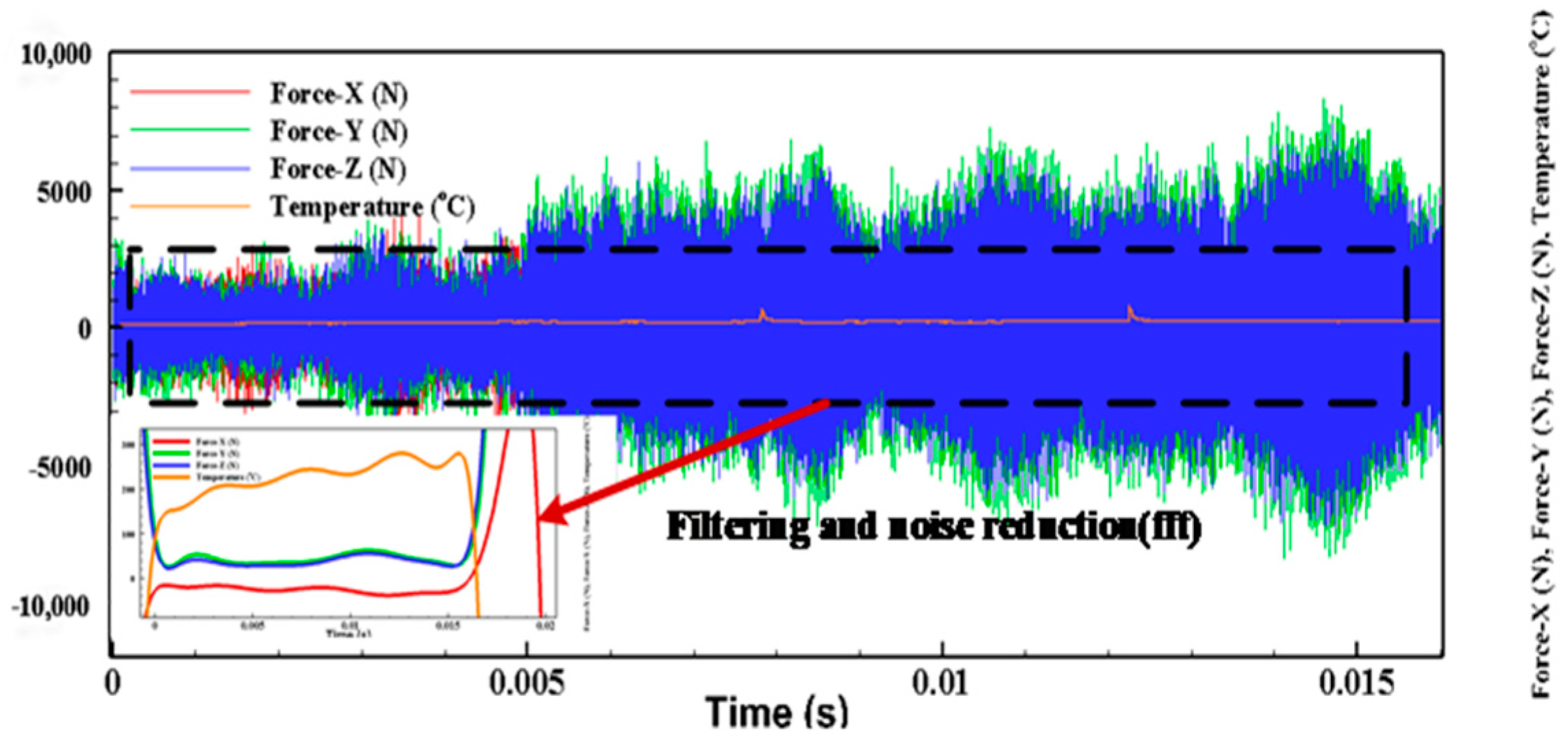
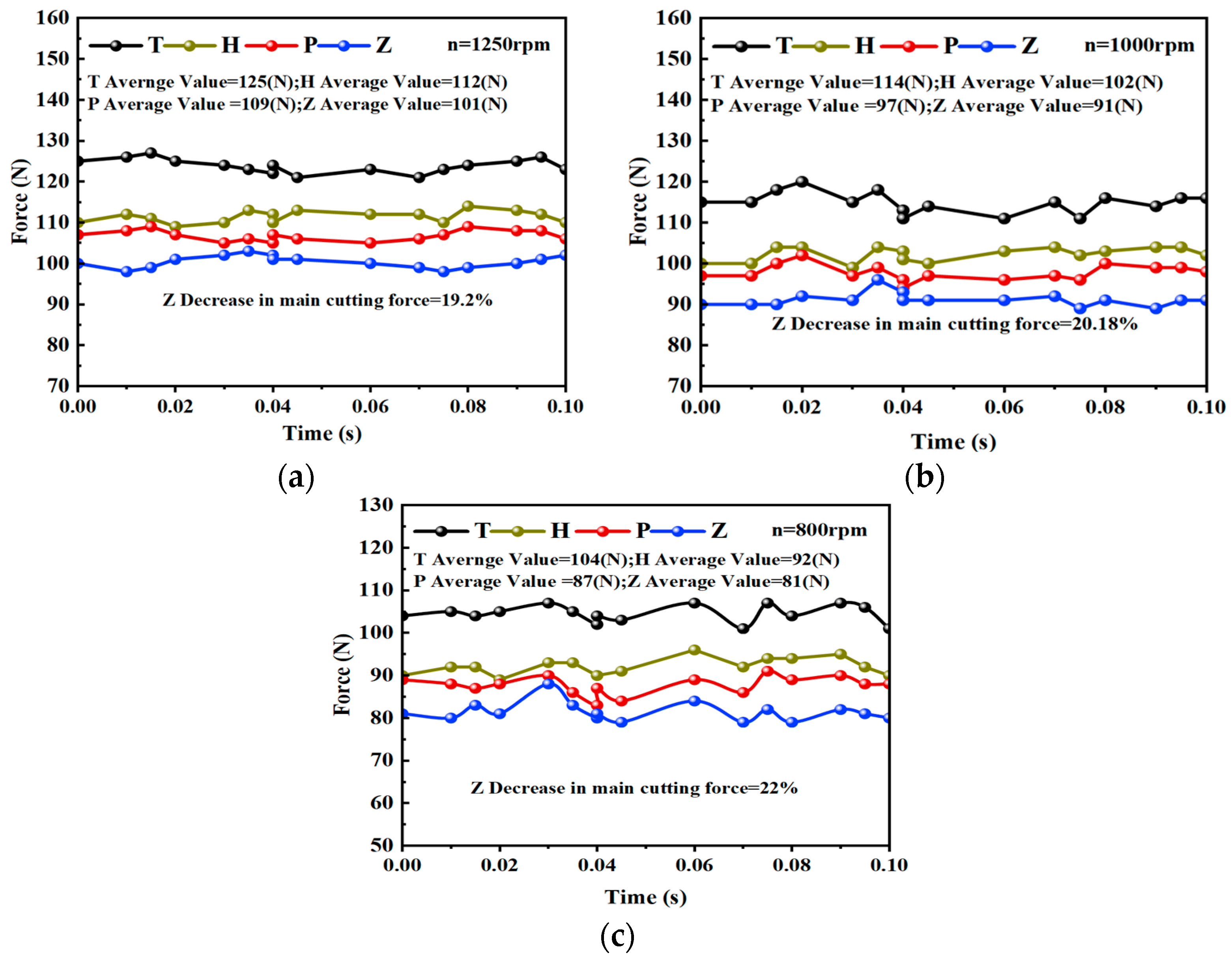

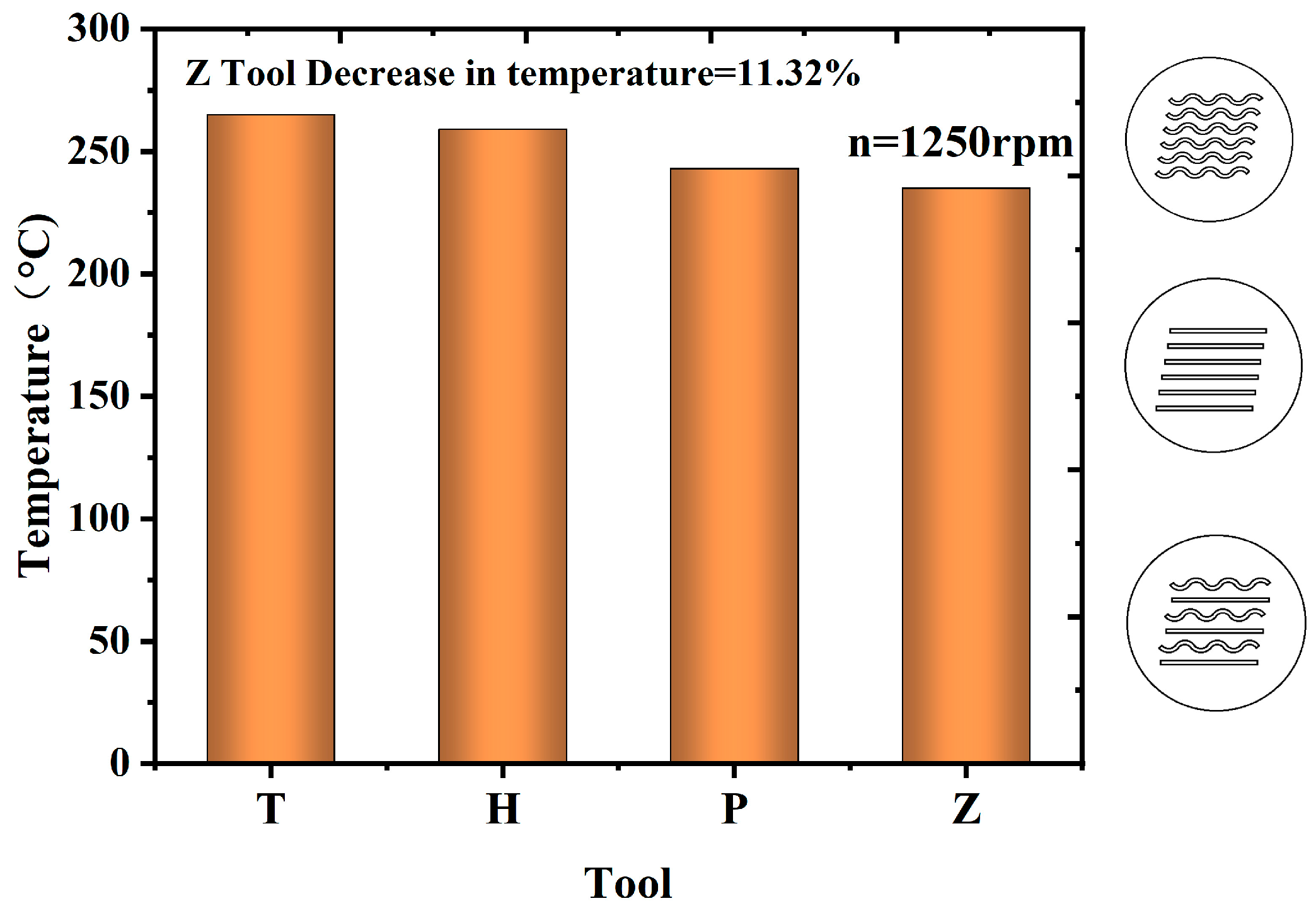




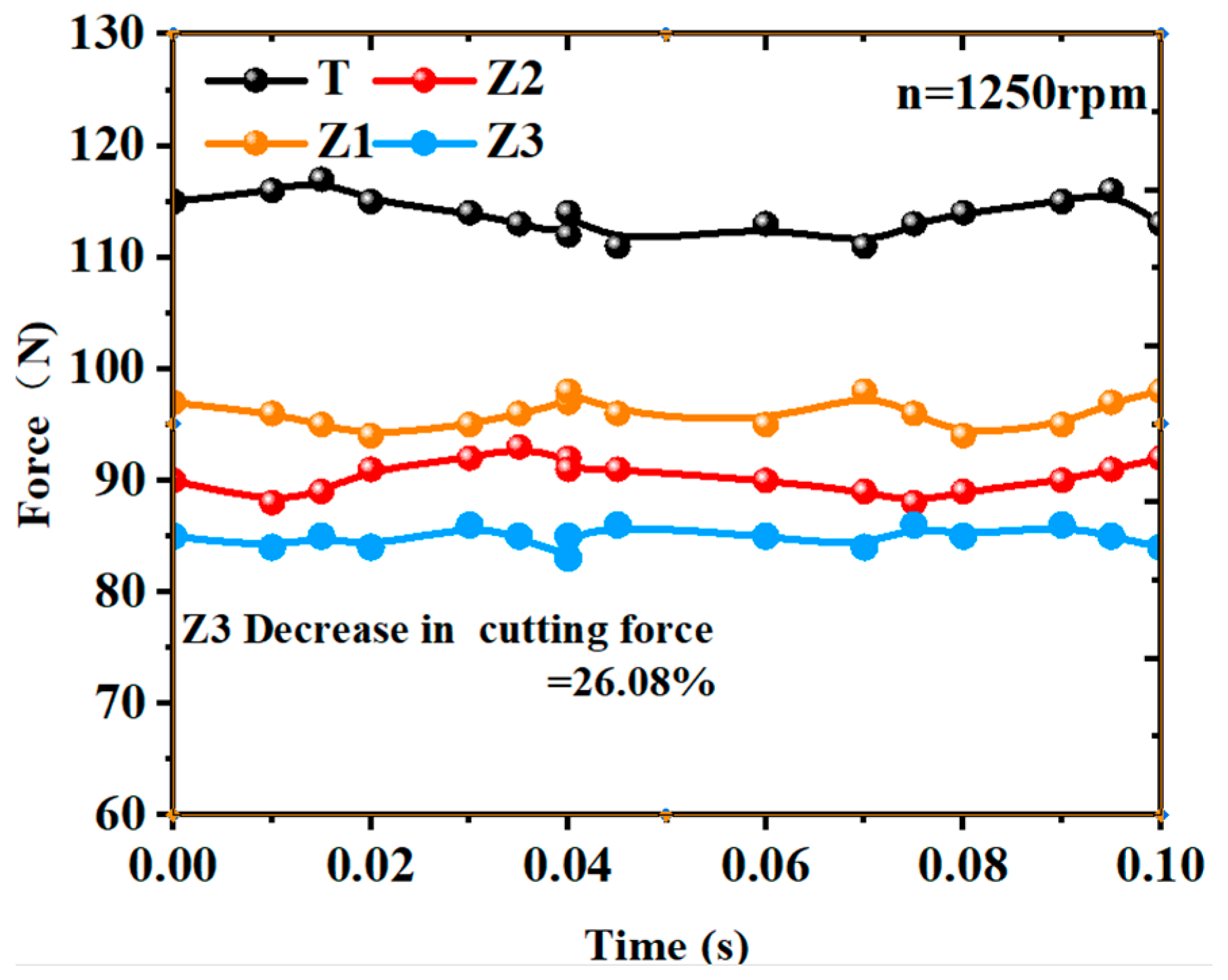
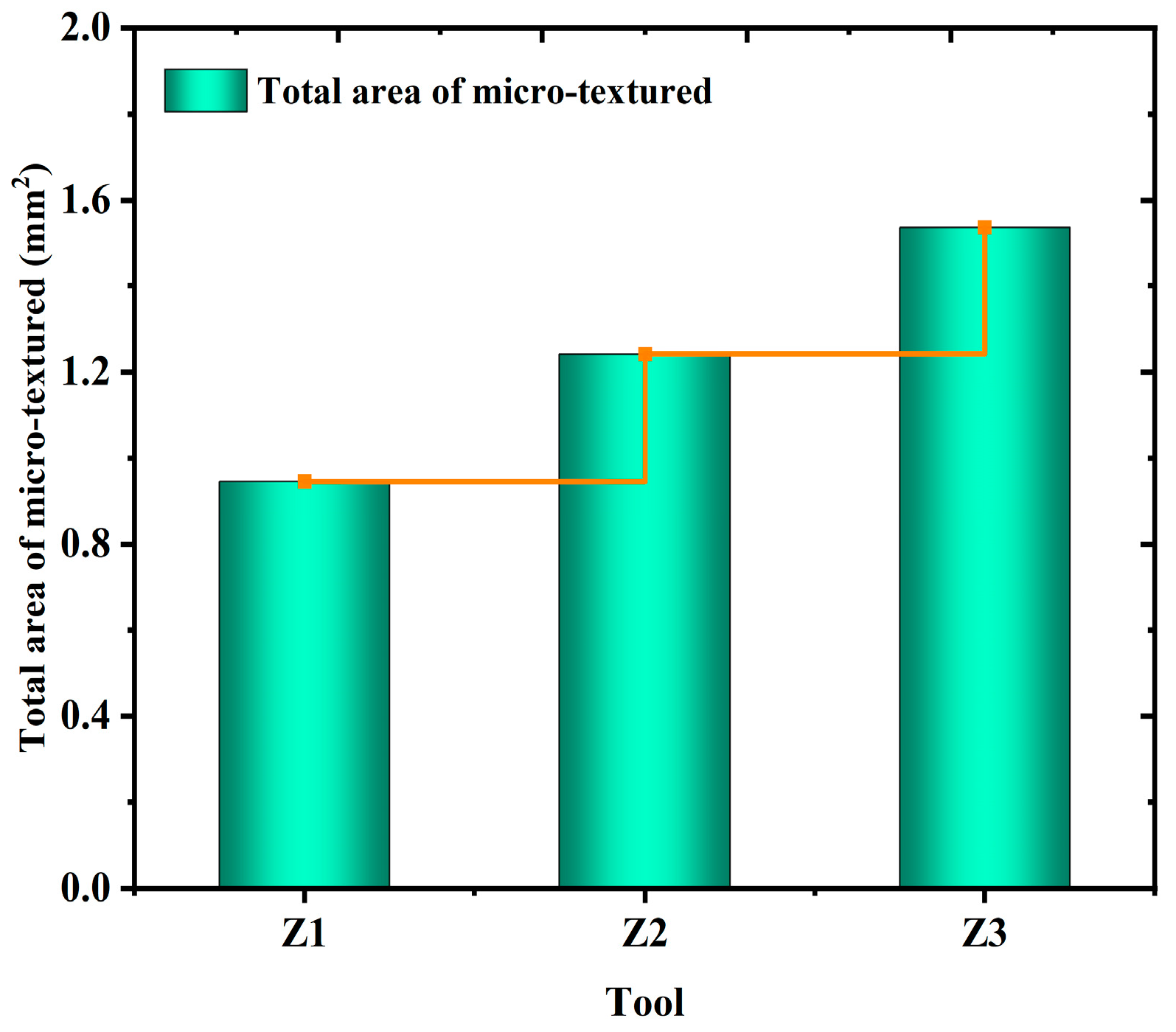
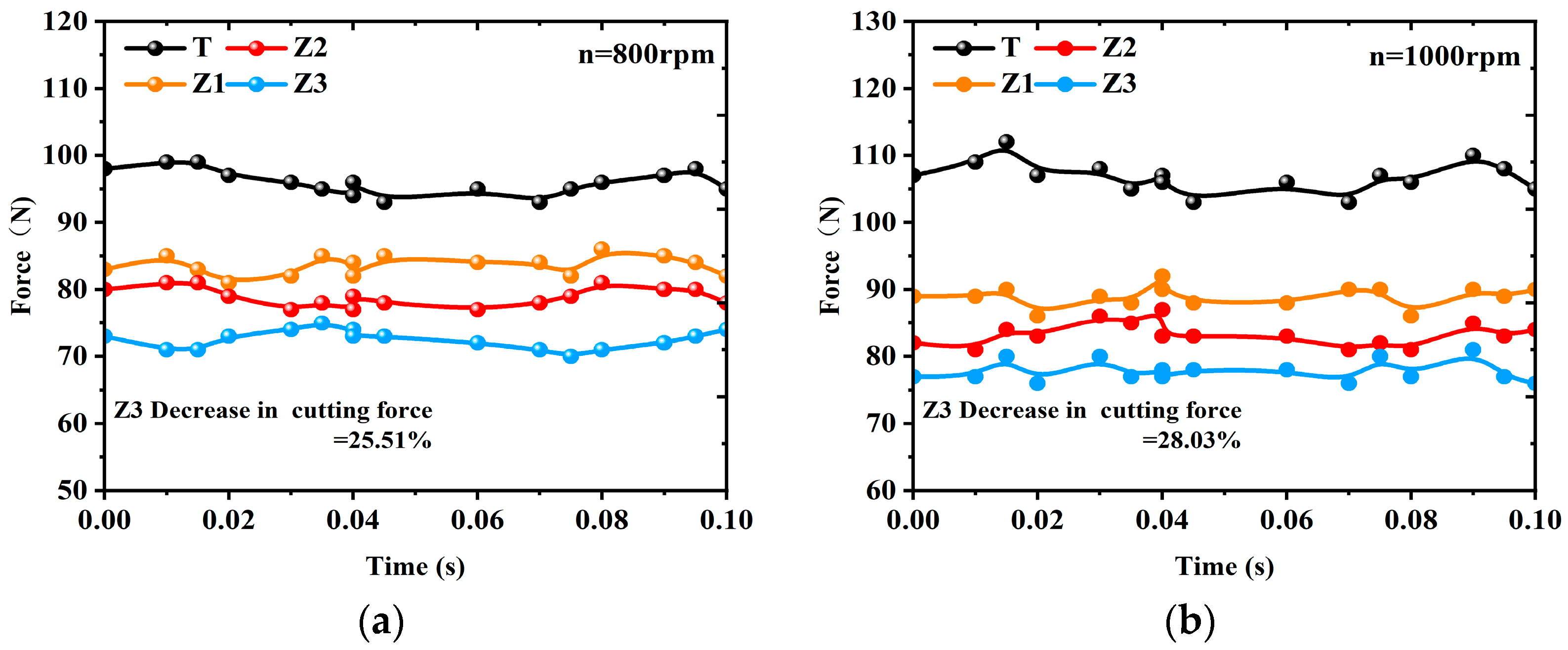
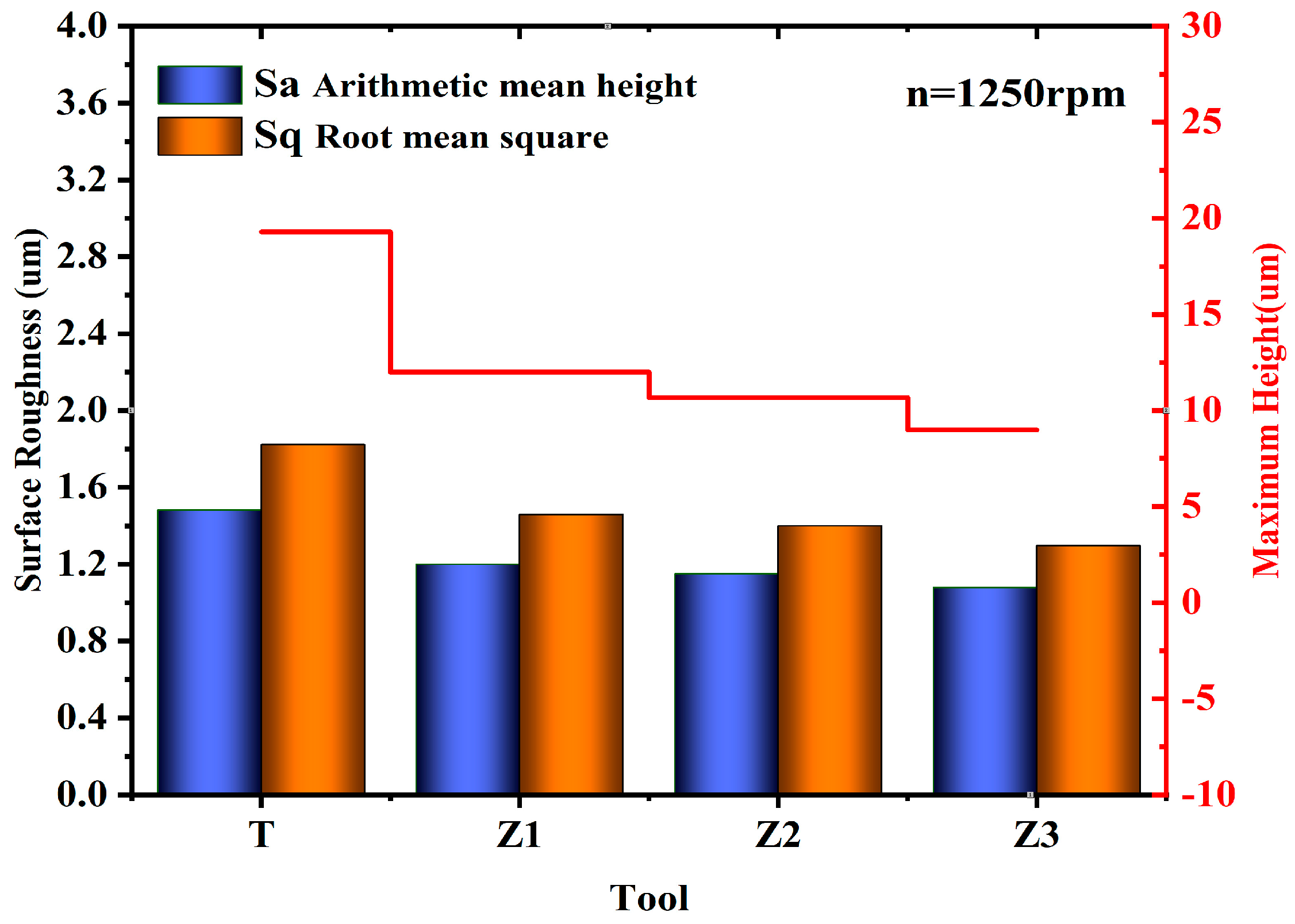

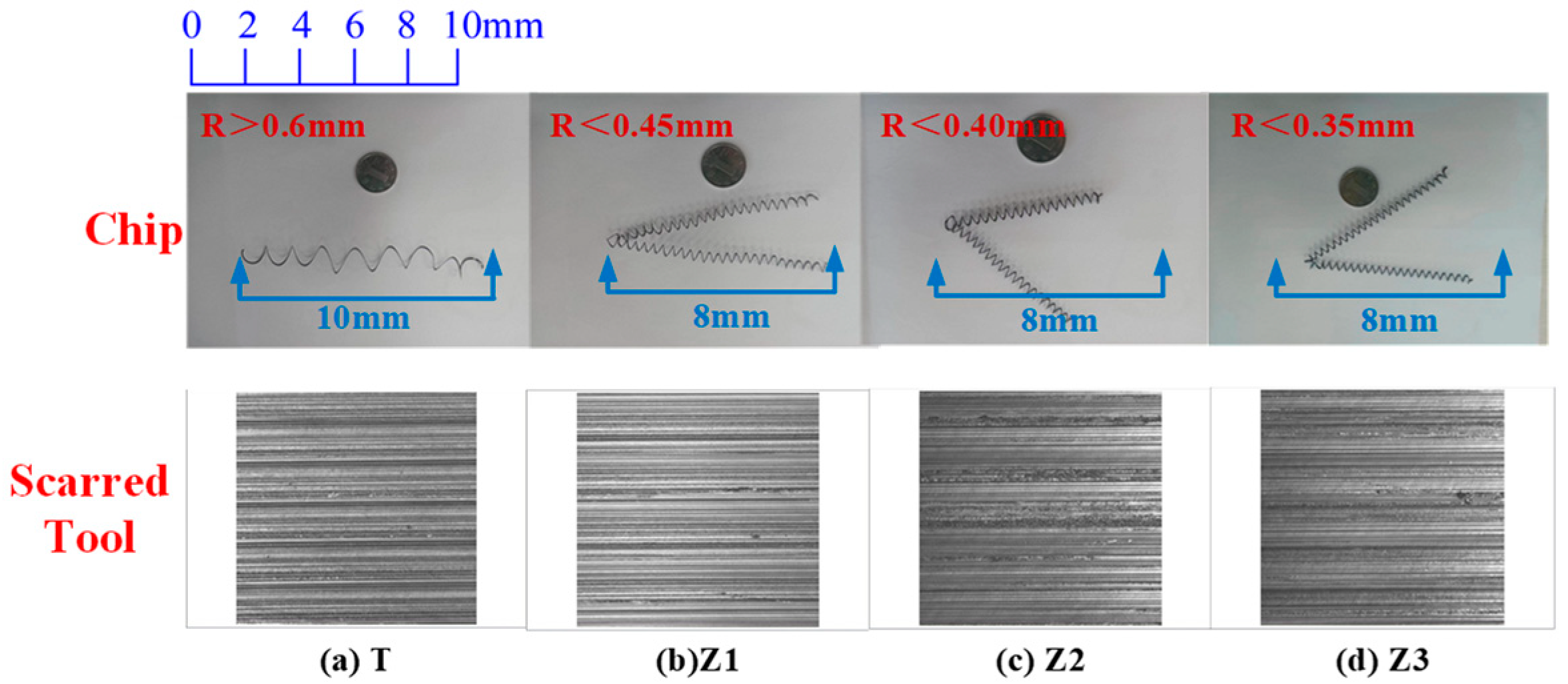
| A (GPa) | B (GPa) | C | n | m | t0 (°C) | tm (°C) |
|---|---|---|---|---|---|---|
| 1.204 | 1.208 | 0.036 | 0.12 | 0.89 | 20 | 1180 |
| Material Properties | Young’s Modulus (Gpa) | Thermal Conductivity (W/m·K) | Poisson Ratio | Density (g/cm3) | Specific Heat (J/kg k) |
|---|---|---|---|---|---|
| Value | 210 | 43 | 0.3 | 7.85 | 458 |
| Tool | Distance (µm) | Depth (µm) | Width (µm) | Length (µm) |
|---|---|---|---|---|
| Z1 | 150 | 70 | 50 | 1200 |
| Z2 | 200 | 70 | 50 | 1200 |
| Z3 | 300 | 70 | 50 | 1200 |
| C | Si | Mn | S | P | Cr | Mo |
|---|---|---|---|---|---|---|
| 0.95–1.05% | 0.15–0.35% | 0.20–0.40% | ≤0.020% | ≤0.027% | 1.40–1.65% | 0.08–0.15% |
| Group | Cutting Speed (rpm) | Feed f (mm/r) | Depth of Cut ap (mm) |
|---|---|---|---|
| 1 | 800 | 0.15 | 0.2 |
| 2 | 1000 | 0.15 | 0.2 |
| 3 | 1250 | 0.15 | 0.2 |
Disclaimer/Publisher’s Note: The statements, opinions and data contained in all publications are solely those of the individual author(s) and contributor(s) and not of MDPI and/or the editor(s). MDPI and/or the editor(s) disclaim responsibility for any injury to people or property resulting from any ideas, methods, instructions or products referred to in the content. |
© 2023 by the authors. Licensee MDPI, Basel, Switzerland. This article is an open access article distributed under the terms and conditions of the Creative Commons Attribution (CC BY) license (https://creativecommons.org/licenses/by/4.0/).
Share and Cite
Xu, T.; Ma, C.; Shi, H.; Xiao, K.; Liu, J.; Li, Q. Effect of Composite Bionic Micro-Texture on Cutting Performance of Tools. Lubricants 2024, 12, 4. https://doi.org/10.3390/lubricants12010004
Xu T, Ma C, Shi H, Xiao K, Liu J, Li Q. Effect of Composite Bionic Micro-Texture on Cutting Performance of Tools. Lubricants. 2024; 12(1):4. https://doi.org/10.3390/lubricants12010004
Chicago/Turabian StyleXu, Tiantian, Chunlu Ma, Hu Shi, Kai Xiao, Jinpeng Liu, and Qinghua Li. 2024. "Effect of Composite Bionic Micro-Texture on Cutting Performance of Tools" Lubricants 12, no. 1: 4. https://doi.org/10.3390/lubricants12010004




